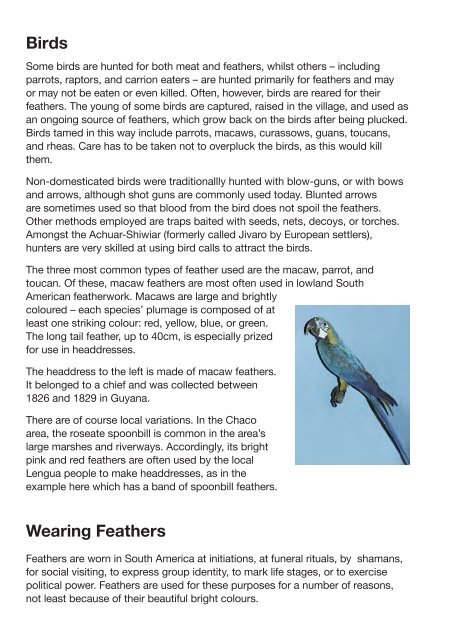Create successful ePaper yourself
Turn your PDF publications into a flip-book with our unique Google optimized e-Paper software.
Birds<br />
Some birds are hunted for both meat and feathers, whilst others – including<br />
parrots, raptors, and carrion eaters – are hunted primarily for feathers and may<br />
or may not be eaten or even killed. Often, however, birds are reared for their<br />
feathers. The young of some birds are captured, raised in the village, and used as<br />
an ongoing source of feathers, which grow back on the birds after being plucked.<br />
Birds tamed in this way include parrots, macaws, curassows, guans, toucans,<br />
and rheas. Care has to be taken not to overpluck the birds, as this would kill<br />
them.<br />
Non-domesticated birds were traditionallly hunted with blow-guns, or with bows<br />
and arrows, although shot guns are commonly used today. Blunted arrows<br />
are sometimes used so that blood from the bird does not spoil the feathers.<br />
Other methods employed are traps baited with seeds, nets, decoys, or torches.<br />
Amongst the Achuar-Shiwiar (formerly called Jivaro by European settlers),<br />
hunters are very skilled at using bird calls to attract the birds.<br />
The three most common types of feather used are the macaw, parrot, and<br />
toucan. Of these, macaw feathers are most often used in lowland South<br />
American featherwork. Macaws are large and brightly<br />
coloured – each species’ plumage is composed of at<br />
least one striking colour: red, yellow, blue, or green.<br />
The long tail feather, up to 40cm, is especially prized<br />
for use in headdresses.<br />
The headdress to the left is made of macaw feathers.<br />
It belonged to a chief and was collected between<br />
1826 and 1829 in Guyana.<br />
There are of course local variations. In the Chaco<br />
area, the roseate spoonbill is common in the area’s<br />
large marshes and riverways. Accordingly, its bright<br />
pink and red feathers are often used by the local<br />
Lengua people to make headdresses, as in the<br />
example here which has a band of spoonbill feathers.<br />
Wearing <strong>Feather</strong>s<br />
<strong>Feather</strong>s are worn in South America at initiations, at funeral rituals, by shamans,<br />
for social visiting, to express group identity, to mark life stages, or to exercise<br />
political power. <strong>Feather</strong>s are used for these purposes for a number of reasons,<br />
not least because of their beautiful bright colours.

















